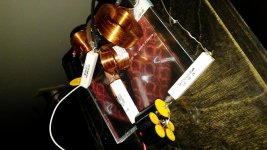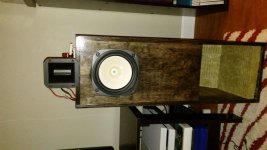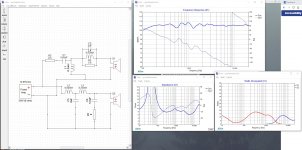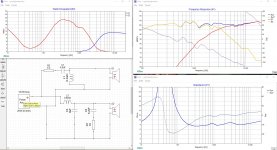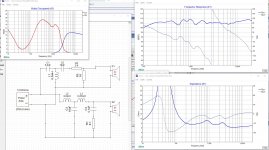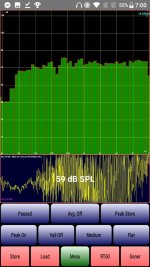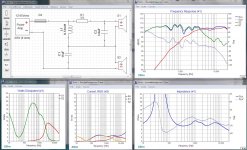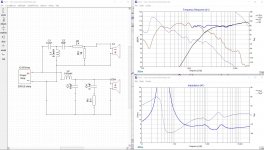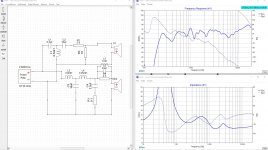Absolutely. People see it on paper and it drives them crazy. They can often come to quick and harsh assumptions. Ha ha people are people...
So. I can't thank you enough for this. Threw on some Julia Jacklin and it's absolutely everything I could hope for. The drivers integrate perfectly, and imaging is absurd in a much-less-than-ideal room. Will post pictures of my horrible soldering work in a bit. (To make that 5.85ish uF capacitance, I had to parallel six capacitors, as I had a ton of 0.1uF/0.33uF film-foils and 5.1uF metallized films laying around. Life hacks.)
Last edited:
Frankenstein brings his creature to life. Ha ha well done! Sometimes when you get up and running there is work yet to be done? 9 times out of 10, I always keep tuning the tweeters. Secondly it is the ported vent tuning.
Frankenstein brings his creature to life. Ha ha well done! Sometimes when you get up and running there is work yet to be done? 9 times out of 10, I always keep tuning the tweeters. Secondly it is the ported vent tuning.
Folded horn was a bit of kit. Lightly stuffed, with a bit of Roxul at the mouth.
Attachments
Getting a little closer to being finished. Tweaked a few values and put in the DCR of the inductors to get a bit more accurate representation. Hopefully next month I'll have a calibrated microphone to start testing with, and I'll go from there. Values are pretty much +-3dB, which is definitely a good place to start. Looking at the dissipation curves, should be able to get a continuous 105dB output (tweeter rated 12W nominal, 25W max), with an additional 3dB dynamic headroom.
Attachments
Last edited:
Getting a little closer...
Nice work. Looks like you are running your tweeters a little hot to get a flat simulation result. Run it cooler with a higher value R2 until you 'mic/measure' for final results and try not to drive the set-up hard until then. When I first started using Fountek ribbons, I blew $350 by trying random stuff without paying attention to the limits of the tweeters. I said it before and I will say it again, there is a learning curve to design/deploy Fountek ribbon tweeters via passive component crossover. In my early days of using those ribbons I followed crossover schematics I found to be proven/tested on the internet only to find out those designs were totally inferior. So keep your power down and don't blow your tweeters until you have a proven design. Best of luck to you, sounds like you are dialing it in.

Last edited:
Nice work. Looks like you are running your tweeters a little hot to get a flat simulation result. Run it cooler with a higher value R2 until you 'mic/measure' for final results and try not to drive the set-up hard until then. When I first started using Fountek ribbons, I blew $350 by trying random stuff without paying attention to the limits of the tweeters. I said it before and I will say it again, there is a learning curve to design/deploy Fountek ribbon tweeters via passive component crossover. In my early days of using those ribbons I followed crossover schematics I found to be proven/tested on the internet only to find out those designs were totally inferior. So keep your power down and don't blow your tweeters until you have a proven design. Best of luck to you, sounds like you are dialing it in.
Can't quite drive it that hard anyway. I've got about 18 watts on tap with the solid state amp. 😛
I have a couple 3.3 ohm resistors that I can swap in later if I decide to push past 3-4 watts. At 20W power, XSim dissipation shows just under 10W dissipation with 3.3 ohms for R2 instead of 12.5 for the current 2.4 ohm R2.
Last edited:
Slight update to get the phase and impedance as clean as possible. Removed the 1 ohm resistor across the 0.3mH inductor to pull out some dissipation out of the 1-2k range on the tweeter, as well as removing the 0.25mH inductor, and increasing the zobel network impedance (Threw in that 3.3 ohm resistor!). Impedance remains between 7 and 9 ohms beyond 200Hz, and phase +- 10 degrees from 400Hz up. At 20W, max tweeter dissipation is around 11.25W. I'll be making little optimizations here and there in the future.
Attachments
Finally got my iMM-6 calibrated measurement microphone in. This little thing is pretty neat. Took out the BSC (it was exacerbating the peaks in midrange response) and tidied up the crossover a bit more. C3 in the circuit (LPF shunt cap) was increased, which caused the summing to be best with both drivers in phase. With 20W input power, the tweeter is seeing 11.4W, nominal impedance is around 7ish ohms. Ignore the 300ish Hz room mode, I wasn't able to take a gated response (I need to get a TRRS extension to use REW, currently using AudioTool for Android with the calibration file loaded). Response was taken 15 degrees off-axis at 1m distance (accounting for no toe-in at the listening position).
Attachments
Please upload your DXO file from XSim... lets see what we can do.
Uploaded.
Have to keep dissipation below 2kHz at a minimum on the tweeter to prevent burning out the ribbon (even then, it's only capable of 12W RMS output). The woofer is the tough bit. LCR filter is still on the table for the tweeter, but I sit off-axis with no toe-in. Once I get a TRRS extension cable, I'll have some spectral decay and gated response graphs up.
Attachments
The immediate problem seems to be that the Fostex appears to be a full range driver. As such it's going to have a lower coil inductance than a regular woofer would have, making it very hard to manipulate at higher frequencies. Plus it seems to have some odd dips in frequency response between about 800 and 1500 hz that are going to interfere with any crossover point near there.
The attached thumbnail and dxo are about as close as you're likely to get it without either going full ape man on the woofer or frying the tweeter. (Please note R4 can be omitted from the final design, it's only there to monitor current)
Is there a different bass driver you could use?
I hope this helps...
The attached thumbnail and dxo are about as close as you're likely to get it without either going full ape man on the woofer or frying the tweeter. (Please note R4 can be omitted from the final design, it's only there to monitor current)
Is there a different bass driver you could use?
I hope this helps...
Attachments
Last edited:
The immediate problem seems to be that the Fostex appears to be a full range driver. As such it's going to have a lower coil inductance than a regular woofer would have, making it very hard to manipulate at higher frequencies. Plus it seems to have some odd dips in frequency response between about 800 and 1500 hz that are going to interfere with any crossover point near there.
The attached thumbnail and dxo are about as close as you're likely to get it without either going full ape man on the woofer or frying the tweeter. (Please note R4 can be omitted from the final design, it's only there to monitor current)
Is there a different bass driver you could use?
I hope this helps...
Their quoted coil inductance is silly. The Le of the actual driver is 0.4-0.45mH (measured with DATS), so it has a good amount of rise. The peaks and dips are due to cone resonance (such is the life of a lightweight pulp cone).
The minimum recommended crossover is a third-order at 2500Hz. I could probably squeak by with a 2nd order at 3k, but I really need the lowest possible crossover point, as the woofer's off-axis response starts to drop off around 2.2-2.3kHz.
I was originally planning to use a Dayton PA-165 in a 3-way arrangement with a 15" woofer, but that driver presented far more problems (nasty breakup at 3k) than it was worth. I would go with a smaller cone, but sensitive 4" cones (at least 92dB/W) are very hard to come by.
Integrating ribbons is hard. I miss phenolic ring tweeters.
Last edited:
Integrating ribbons is hard. I miss phenolic ring tweeters.
I hear ya.
Well you can tinker with the shunt design easily enough, lets hope it's some help to you.
One thought is to worry less about nodes and off-axis response. I doubt you're going to get that right anyway. Speakers are pretty broad strokes devices, be careful not to get fixated on the minutia.
Update time! I was able to solder a couple cables to the TRRS plug on my iMM-6 to output to TRS mic input and got a FRD for the Fostex driver loaded in the horn (gated to 5.5ms, so <200Hz response isn't useful). It's still a little hot around 1k.
Attachments
Minor Update: LRC filter update has the 1k hotspot down a couple dB, so that most everything falls into a nice comfy +- 2dB range. Pulled the Zobel cap down again to get the crossover to sum a little better.
The waterfall plot on this Fostex is surprisingly good. Not much stored energy.
The waterfall plot on this Fostex is surprisingly good. Not much stored energy.
Attachments
Last edited:
So, I've been taking off-axis measurements, and this isn't gonna work out. Not really due to the crossover, but physical driver integration. On-axis with the tweeter is an absolute mess, whereas on-axis with the woofer (tweeter above listening level) actually looks quite nice. Move left or right, and things fall apart just as quickly. :|
So, I've been taking off-axis measurements, and this isn't gonna work out. Not really due to the crossover, but physical driver integration. On-axis with the tweeter is an absolute mess, whereas on-axis with the woofer (tweeter above listening level) actually looks quite nice. Move left or right, and things fall apart just as quickly. :|
So, I got right back to it after a few days of taking a break. Included the mod delays, moved the crossover point a bit higher, and 3D printed a rounded baffle for properly mounting the tweeter. Gonna keep taking a stab at this until I can get it to work.
- Home
- Loudspeakers
- Multi-Way
- Troubleshooting A Tricky Crossover
